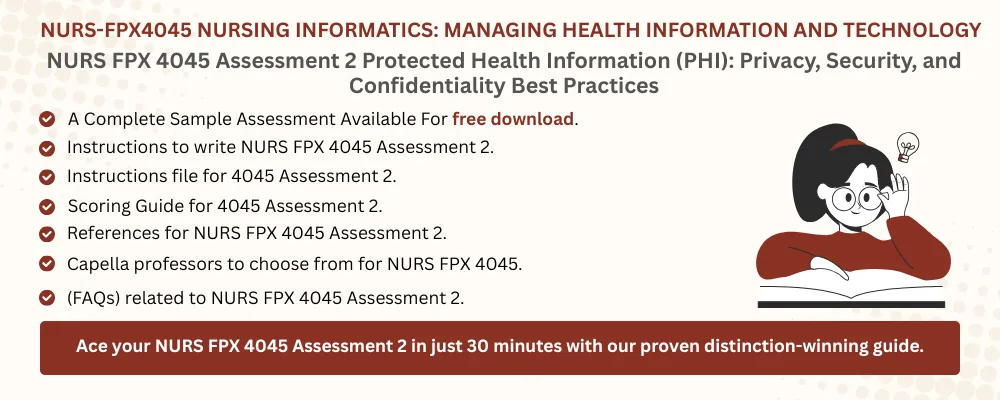NURS FPX 4045 Assessment 2 Sample FREE DOWNLOAD
NURS FPX 4045 Assessment 2
Protected Health Information (PHI): Privacy, Security, and Confidentiality Best Practices
Student name
Capella University
NURS-FPX4045 Nursing Informatics: Managing Health Information and Technology
Professor Name
Submission Date
Protected Health Information (PHI): Privacy, Security, and Confidentiality Best Practices
Protected Health Information (PHI) is any personal health information that may identify an individual and any information collected, used, stored, or transferred by a covered entity or business associate in any manner (whether electronic, written, or oral). The Health Insurance Portability and Accountability Act (HIPAA) of 1996 sets a range of harsh rules regarding the PHI treatment to provide the confidentiality of patients and their data protection (Centers for Disease Control and Prevention, 2024). PHI typically holds sensitive data of the members of research institutions, and in a clinical trial, such as medical histories, test outcomes, and genetic details. Breach violations occurred in the case of sharing research findings, participation information, or even some simple observation without permission. The HIPAA Privacy Rule offers the protection of PHI, but the Security Rule is exclusively dedicated to the protection of electronic health information. To comply with these guidelines, the researchers will work on secure data storage systems, encrypted communication, and informal consent should be obtained before information of the participants can be accessed or shared.
Confidentiality Laws
- Privacy in research facilities and their trial will mean that the subjects can make decisions about other individuals who may have access to their personal health and research information. This includes not sharing and discussing data, consent forms, and study results without the express approval of the participant.
- Security: Application of high-technical security controls, which involve encryption, password protection, safe databases, and systems that are HIPAA compliant to prevent unauthorized access or even loss of electronic research records (U.S. Department of Health and Human Services, 2024).
- Confidentiality means that the research team must remember that the identity of the participants, among other sensitive information, will remain confidential. The sharing of any identifiable or study-related information in reports, presentations, and social media, both intentional and not, is a violation of HIPAA regulations.
- Interdisciplinary cooperation is core within the compliance upholding process. Researchers, IT experts, data managers, and institutional review boards must collaborate to support the welfare of information security and confidentiality of the entire information that is owned by the participants to uphold conformity with consistent rules and maintain clear communication to ensure all crucial information is secured throughout the research period.
Interdisciplinary Collaboration
- The collaboration with the representatives of other disciplines is the point that legitimizes the ethical principles and information integrity of research facilities and clinical trials (Research, 2024). Cooperation is vital in such an environment as it ensures that all aspects of HIPAA compliance and data security are dealt with properly.
- One such area is that informed consent should be sought, and the data of the respondents should be preserved by the researchers during data collection. IT professionals ensure that research databases and communication systems are encrypted, and they use secure servers, as well as limit accessibility is limited. The administrative staff will be included in the appropriate record keeping, data storage, and handling of sensitive material in the research.
- Interdisciplinary cooperation is the interrelation of various disciplines to enhance the security of data and quality of research ( Research, 2024). The team meetings and privacy training, as well as shared responsibility, would help establish a routine to minimize the risk of PHI breach. With the existence of a highly informed team that is well-knit, a safe environment will be formed in which research can be conducted in a manner that is responsible and ethical.
- Participant’s secrecy is not only an ethical requirement but also a legal of all research professionals, and the foundation of trust, credibility, and research excellence of scientific research (Sony et al., 2025).
Mitigation of Risks
- The research institution and clinical trial teams should be provided with certified data management systems with end-to-end encryption, automated session timeouts, and secured data storage. CTMS and REDCap are explicitly designed to accomplish the HIPAA and research compliance standards.
- The limitation of access to research data, according to some job activities, will reduce idle exposure. One would be the fact that the consent forms or a schedule would be handled by an administrator, and only authorized researchers would receive access to a detailed participant health record or genetic information. This will increase accountability and create information security.
- Cybersecurity, phishing mitigation, and breach response training should also be provided regularly to reduce the possibility of human error and guarantee compliance (Zaidy, 2020).
- A bright example of this was when the University of Rochester Medical Center was forced to settle for 3 million dollars after it was found out that secure health information had been leaked not only because of losing an unencrypted flash disk, but also because of losing an unencrypted laptop. This breach was reported many years following a previous breach, even though caution had been raised previously that the lack of encryption is a high threat to the electronic protected health information (ePHI) (Secureframe, 2023).
Staff Update
- The regular staff training in research institutions is elaborated based on real-life examples to stimulate safe communication on the Internet and the prevention of the confidentiality breach of the participants. During these sessions, the staff will be able to train how seemingly innocent posts or commentary can result in gross intrusion into privacy (Zaidy, 2020).
- To promote the sense of responsibility and ensure that all people are informed about the ethical and legal standards of PHI utilization in research centers, one should establish transparent social media and data-sharing regulations, in addition to making the staff aware that they must behave in a specific way (Zaidy, 2020).
- Study data and personal data of participants will not be transferred using personal equipment or shared on any other data platform that does not meet the requirements of HIPAA, as this will contribute to preventing the loss of confidential information to the wrong hands or its inadvertent disclosure.
- Most of the companies encourage the pause before you post or share attitude, whereby researchers and employees must consult their compliance officers or supervisors on whether they should place or share any material concerning the study on the internet. The practice will contribute to the prevention of unintentional infractions and will facilitate the credibility of the research among the community.
Conclusion
The security and privacy of the data of individuals are vital in the study institutions and clinical trials. Data breaches are prevented by the cooperation of research teams and compliance with the standards of HIPAA. The risk of unauthorized disclosures is addressed by this training of staff and security data systems. The responsibility of ensuring that the sensitive information of the research is not compromised lies in trust maintenance to all those concerned.
Need help with NURS FPX 4045 Assessment 3? Click here for tutoring and sample solutions!
Instructions To Write NURS FPX 4045 Assessment 2
If you need guidance to write NURS FPX 4045 Assessment 2 Protected Health Information (PHI): Privacy, Security, and Confidentiality Best Practices, contact Tutors Academy. Our expert tutors are ready to assist you.
Instruction file for 4045 Assessment 2
Contact us to get the instruction file for this assessment.
Scoring Guide for 4045 Assessment 2
Contact us to get the Scoring file for this assessment.
References For NURS FPX 4045 Assessment 2
Centers for Disease Control and Prevention. (2024, September 10). Health insurance portability and accountability act of 1996 (HIPAA). Public Health Law; Centers for Disease Control and Prevention. https://www.cdc.gov/phlp/php/resources/health-insurance-portability-and-accountability-act-of-1996-hipaa.html
Research, M. (2024, August 27). What is Data Integrity and Why Is It Important in Clinical Research? Minerva Research Solutions. https://minervaresearchsolutions.com/what-is-data-integrity/
Secureframe. (2023). HIPAA Violations: 5 Cases to Learn from. Secureframe. https://secureframe.com/hub/hipaa/violations
Sony, E., Ali, E., Cletus, E., Agbakhamen, O., Ogheneteme, E., & Okoro, P. (2025). Ethical standards in research: A professional imperative. International Journal of Innovative Scientific & Engineering Technologies Research, 13(1), 94–104. https://doi.org/10.5281/zenodo.14875237
U.S. Department of Health and Human Services. (2024). Summary of the HIPAA Security Rule. U.S. Department of Health and Human Services. https://www.hhs.gov/hipaa/for-professionals/security/laws-regulations/index.html
Zaidy, A. A. (2020, November 1). Impact of Training on Employee Actions and Information Security Awareness in Academic Institutions. ResearchGate. https://doi.org/10.13140/RG.2.2.18935.96168
Best Professors To Choose From For 4045 Class
Erica Alexander.
Elisea Avalos.
Jennifer Carroll.
JoAnna Cartwright.
Lisa Kreeger.
(FAQs) related to NURS FPX 4045 Assessment 2
Question 1: From where can I download a free sample for NURS-FPX 4045 Assessment 2?
Answer 1: You can download a free sample for NURS-FPX 4045 Assessment 2 from the Tutors Academy website.
Question 2: Where can I find the instructions and rubric file for NURS-FPX 4045 Assessment 2?
Answer 2: You can find the rubric and instruction files for this assessment on the Tutors Academy sample page for NURS-FPX 4045 Assessment 2.
Do you need a tutor to help with this paper for you with in 24 hours.
- 0% Plagiarised
- 0% AI
- Distinguish grades guarantee
- 24 hour delivery

